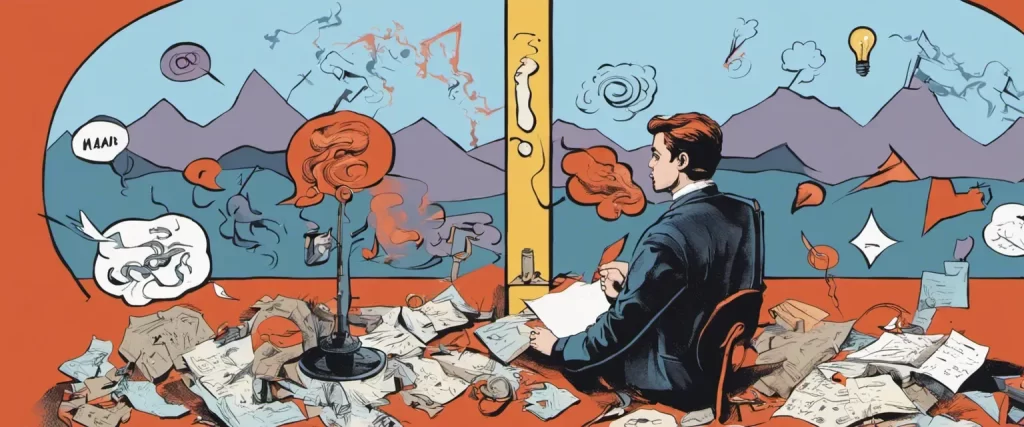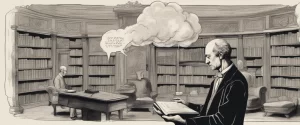——The Reason I Jump by Naoki Higashida & The Man Who Couldn’t Stop by David Adam
Books have an incredible ability to transport us into the minds and experiences of others, to unravel the complexities of the human condition, and to shed light on our shared struggles and triumphs. In this comparative study, we delve into two remarkable books that offer unique perspectives on neurodiversity and the intricacies of living with neurological conditions. Naoki Higashida’s “The Reason I Jump” and David Adam’s “The Man Who Couldn’t Stop” provide readers with valuable insights into the world of autism and obsessive-compulsive disorder (OCD), respectively. These captivating narratives offer readers an intimate understanding of the challenges faced by individuals living with these conditions, ultimately inviting us to question our preconceptions and broaden our empathy towards those who experience the world differently.
The Reason I Jump” by Naoki Higashida is an extraordinary literary work that revolutionizes our understanding of autism. Naoki, a nonverbal Japanese teenager with autism, eloquently expresses his thoughts, emotions, and sensory experiences through breathtaking prose. Through a series of questions and answers, Naoki unveils the inner workings of his mind, debunking common misconceptions about autism and unveiling a world misunderstood by many. “The Reason I Jump” is not only an autobiographical account but also a bridge between autistic individuals and a society often ignorant of their unique perspectives.
On the other hand, “The Man Who Couldn’t Stop” by David Adam takes us on an enlightening journey into the realm of OCD, a condition characterized by persistent and uncontrollable thoughts, obsessions, and rituals. Adam, an award-winning science writer and journalist, courageously shares his personal battle with OCD and examines its historical, psychological, and societal aspects. By intertwining personal experiences with scientific research, Adam offers readers a compassionate and insightful exploration of the condition, dispelling myths and providing a deeper understanding of the life-altering impact OCD can have on an individual.
Both books, despite focusing on different neurological conditions, share a common goal of breaking down stereotypes and fostering compassion and empathy towards those who experience the world differently. Naoki and David both provide a genuine and intimate portrayal of their daily struggles, inviting readers to partake in their journeys and challenging us to reconsider our perceptions of neurodiversity. By comparing and contrasting these works, we aim to highlight the common threads that unite these deeply personal narratives while acknowledging the unique experiences and perspectives each author brings to their respective conditions.
In the following comparative study, we will examine several key aspects, including the authors’ narrative styles, the portrayal of sensory experiences, the challenges faced by the individuals in their journey, and the societal perceptions and stigmas surrounding their conditions. By exploring these elements in tandem, we aim to gain a broader understanding of neurodiversity and recognize the shared humanity that underlies the diverse experiences of individuals living with autism and OCD.
Through the immersive narratives captured in “The Reason I Jump” and “The Man Who Couldn’t Stop,” Naoki Higashida and David Adam invite us to step outside our own perspectives and walk in their shoes. Their stories serve as powerful testimonials, urging us to rethink our perceptions, embrace diversity, and approach neurodiversity with empathy and understanding. Let us delve into their touching narratives, as we embark on a journey that expands our horizons and challenges our own cognitive limitations.
Brief Summary of Two Books
The Reason I Jump by Naoki Higashida
The Reason I Jump” is a memoir written by Naoki Higashida, a non-verbal autistic teenager from Japan. The book provides a unique perspective into the mind and experiences of individuals with autism. Naoki shares his innermost thoughts and feelings, answering questions about why people with autism behave the way they do.
Structured in a question-and-answer format, Naoki addresses inquiries such as why he repeats movements, why he jumps, and why he seems uninterested in having conversations. He explains that his repetitive behaviors help him to calm down and regulate his anxieties, while jumping gives him a sense of liberation and freedom. He also clarifies that although he may appear disinterested in communicating, his mind is constantly buzzing with thoughts.
Naoki dives into the sensory sensitivities experienced by those with autism, detailing the intensity of their senses and how they perceive the world around them. He opens a window into the overwhelming and chaotic nature of certain environments, explaining how this can lead to meltdowns and the necessity for routine as a coping mechanism.
Additionally, Naoki offers insights into the deep emotional nature of individuals with autism, dispelling the myth that they lack empathy. He shares his intense love for his family and friends, expressing his aspirations, dreams, and desire for connection.
“The Reason I Jump” strives to bridge the gap between autistic individuals and the neurotypical world, fostering understanding and empathy. It is a profound and enlightening account that challenges preconceived notions and invites readers to view autism through a fresh lens, ultimately encouraging greater inclusivity and acceptance.
The Man Who Couldn’t Stop by David Adam
“The Man Who Couldn’t Stop” by David Adam is a non-fiction book that explores the author’s personal experience with Obsessive-Compulsive Disorder (OCD). Adam delves into the history and science behind OCD, providing a comprehensive understanding of the disorder. He examines various treatment methods and therapies and shares his own struggles with OCD, describing his constant battles with intrusive thoughts and the rituals he developed to seek relief. Additionally, the book discusses the connection between OCD and creativity, highlighting how individuals with OCD often possess unique qualities. Overall, “The Man Who Couldn’t Stop” offers both personal insights and scientific knowledge, helping readers gain a deeper understanding of OCD and its impact on individuals’ lives.
Comparison between Two Books

Similarities in Mental Health
Both “The Reason I Jump” by Naoki Higashida and “The Man Who Couldn’t Stop” by David Adam explore mental health topics from different angles, but they share several similarities when examining the portrayal of mental health in these books.
1. First-hand perspective: Both books provide readers with a personal and intimate account from individuals who have experienced mental health challenges. Naoki Higashida, who has autism, shares his firsthand insights and feelings in “The Reason I Jump.” Similarly, David Adam recounts his personal battle with Obsessive-Compulsive Disorder (OCD) in “The Man Who Couldn’t Stop.” The authors share their own experiences, emotions, and struggles, giving readers an authentic understanding of their respective conditions.
2. Breaking stereotypes: Both books challenge stereotypes and misconceptions about mental health. Naoki Higashida’s book shatters many common misconceptions about individuals with autism, illustrating their capacity for self-reflection, empathy, and communication. Similarly, David Adam’s book goes beyond societal stereotypes of OCD being solely about cleanliness, showcasing the complexity, severity, and wide-ranging impacts of the condition. Both books aim to dispel misunderstandings and create more empathy towards individuals with mental health conditions.
3. Psychological insight: Both authors provide valuable psychological insights into their respective conditions. Naoki Higashida offers unique perspectives on autism, delving into the sensory sensitivities and the internal thought processes that affect individuals on the spectrum. David Adam, on the other hand, delves into the intricacies of OCD, discussing various manifestations, the underlying mechanisms of the disorder, and the associated anxiety. Both authors strive to help readers develop a deeper understanding of the psychological dimensions of their conditions.
4. The impact on daily life: Both books vividly describe how mental health conditions affect everyday life experiences. Naoki Higashida shares his struggles with social interactions, the challenges of communication, and the sensory overload he experiences. Similarly, David Adam describes the impact of OCD on his relationships, career, and daily routines. Both authors demonstrate how mental health conditions can profoundly affect various aspects of life and require ongoing management and understanding.
5. The universality of mental health experiences: Both books emphasize the universality of mental health experiences. While Naoki Higashida’s focus is on autism and David Adam’s on OCD, both authors highlight how their experiences and emotions are relatable to anyone facing mental health challenges. They emphasize that beyond the specific conditions they depict, there are universal themes of human struggle and the search for understanding, accepta*
Divergences in Mental Health
The books “The Reason I Jump” by Naoki Higashida and “The Man Who Couldn’t Stop” by David Adam both delve into the topic of mental health but from distinct perspectives and with different focuses. While both books explore the inner workings of the human mind, they diverge in terms of their subject matter, personal experiences, and narrative style.
In “The Reason I Jump,” Naoki Higashida, a nonverbal autistic teenager, shares his experience of living with autism. Through a series of questions and answers, he provides insights into the thought processes and sensory experiences that shape his daily life. The book offers a unique firsthand account, giving readers an opportunity to understand autism from the perspective of someone directly impacted by it. The storytelling is poignant and offers a personal touch, emphasizing the challenges and misunderstandings faced by individuals on the autism spectrum.
On the other hand, “The Man Who Couldn’t Stop” by David Adam explores the realm of obsessive-compulsive disorder (OCD). Adam, who himself suffers from OCD, delves into the history of the disorder, scientific explanations, and personal anecdotes. The book provides a broader context surrounding OCD by examining its portrayal in society and challenging popular misconceptions. Adam blends scientific research with personal experiences, creating a narrative that intertwines factual information with his own journey of living with OCD.
One major divergence between the two books lies in their specific subject matter. Naoki Higashida’s “The Reason I Jump” concentrates exclusively on autism and acts as a window into the inner world of an autistic individual. The book illuminates the unique struggles faced by those on the autism spectrum and aims to increase understanding and acceptance of autism. In contrast, while David Adam’s “The Man Who Couldn’t Stop” illuminates numerous aspects of OCD, it widens its scope to cover historical, cultural, and scientific aspects of the disorder. Adam incorporates personal experiences to enhance the human perspective and promote empathy for those afflicted with OCD.
Another point of divergence is the personal journeys and narratives presented in the books. Naoki Higashida’s book is his own personal account, recounting his individual experiences and thought processes. Through his words, readers gain a profound understanding of what it feels like to live with autism. In contrast, David Adam’s book incorporates his personal experiences with OCD, but it equally draws upon the experiences of others and intertwines them with scientific facts and historical accounts. This approach broadens the narrative beyond personal anecdotes, presenting a more encompassing view of OCD.
Lastly, the writing style and narrative structure differ between the two books. “The Reason I Jump” is written in a question-and-answer format, with each chapter addressing a different aspect of autism. Naoki Higashida’s concise and straightforward writing allows readers to gain unique insights into the mind of an autistic individual. On the other hand, “The Man Who Couldn’t Stop” follows a more traditional storytelling format, combining personal stories, research, and historical anecdotes into a cohesive narrative. David Adam’s prose is engaging and descriptive, offering a deeper exploration of the subject matter.
In conclusion, while both “The Reason I Jump” and “The Man Who Couldn’t Stop” touch upon mental health, they diverge in terms of subject matter, personal experiences, and narrative style. Naoki Higashida’s book focuses exclusively on autism, through his personal account, illuminating autism’s everyday challenges. Meanwhile, David Adam’s book tackles OCD from a broader perspective, incorporating personal stories, historical context, and scientific research to provide a comprehensive exploration of the disorder. Despite their divergences, both books contribute to the understanding and destigmatization of mental health conditions.

Conclusion
Both The Reason I Jump by Naoki Higashida and The Man Who Couldn’t Stop by David Adam are well-regarded books that offer unique perspectives on their respective topics.
The Reason I Jump is written by a young Japanese author with autism, Naoki Higashida, and provides insight into the world of autism from the perspective of someone who experiences it firsthand. It offers readers a deeper understanding of autism and challenges common misconceptions about the condition. This book has been praised for its ability to convey complex emotions and thoughts with clarity and sincerity.
On the other hand, The Man Who Couldn’t Stop is written by David Adam, a science writer who explores his personal experience with obsessive-compulsive disorder (OCD). In this book, Adam provides a blend of scientific research and personal anecdotes to shed light on the nature of obsessive thoughts and compulsive behaviors. The Man Who Couldn’t Stop delves into the history, science, and cultural aspects of OCD, offering readers a comprehensive understanding of the condition.
Both books have received critical acclaim and offer valuable insights into neurological conditions. The decision of which book to read ultimately depends on your personal interests and the specific topic you find more intriguing. If you are more interested in gaining insights into the world of autism, then The Reason I Jump may be the more suitable choice. However, if you are fascinated by OCD and want to explore its manifestations and scientific research, then The Man Who Couldn’t Stop may be the more worthy read for you.



